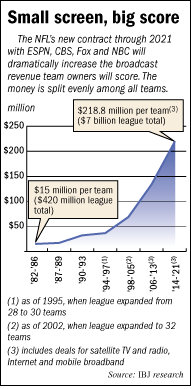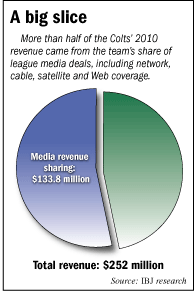Subscriber Benefit
As a subscriber you can listen to articles at work, in the car, or while you work out. Subscribe Now
 National Football League owners on Dec. 14 announced a package of network television deals that should assure the Indianapolis Colts and the league’s other franchises will be financially viable through 2021 without selling a single ticket, suite or sponsorship.
National Football League owners on Dec. 14 announced a package of network television deals that should assure the Indianapolis Colts and the league’s other franchises will be financially viable through 2021 without selling a single ticket, suite or sponsorship.
Officials for the NFL have been hammering out new broadcast agreements with CBS, Fox and NBC that will make the league by far the richest in terms of professional sports broadcast pacts, sources close to the league said.
The owners are expected to sign the deals with the networks at special meetings during Super Bowl week in Indianapolis in February.
For the first time, each of the broadcast networks will pay an annual average of at least $1 billion for the rights to carry NFL games.
Adding in the league’s new eight-year ESPN deal—which pays more than $1.8 billion annually—and agreements for Satellite radio and TV and Internet and broadband, NFL team owners are projected to score a collective $7 billion a year from 2014-2021.
The new contracts are a staggering 64-percent increase over the current ones, which end after the 2013 season.
Since all that money is shared equally among the league’s 32 teams, the Colts will get close to $218.8 million a year from the broadcast and Internet deals starting in 2014. Currently, the Colts get nearly $134 million annually.
The new TV agreements allow the league to withhold more games from coverage by CBS, NBC and Fox. Those games could be bundled into a separate Thursday night package, which could bring in another $1 billion-plus per year for the league. That would boost the Colts’ annual score from league broadcast deals to $222 million.
“That kind of money basically means there is no such thing as a small-market team in the NFL, not from a financial perspective,” said Mark Rosentraub, the University of Michigan dean who was formerly at IUPUI and has written two books about professional sports operations.
“[The Colts] can’t do the same things in terms of ancillary revenue [as] teams in a market like New York, but these [broadcast] deals alone will assure the team will always be able to cover player payroll, by far the team’s greatest expense.”
This year, the Colts will have $220 million in total expenses. Of that, $145 million will be player pay and benefits, according to sports business experts.
The Colts are expected to bring in just more than $250 million in revenue this year, about 53 percent of which comes from the league’s media deals. Ticket sales are projected to bring in less than $60 million.
The NFL’s ability to score huge broadcast deals has assured that the vast majority of teams are profitable. According to Forbes magazine, the Colts have scored profits of $33 million to $56 million each of the last three years.
A stadium deal that has the Colts paying $250,000 in annual rent while the city pays for operational and maintenance costs also helps the team financially. As part of that deal, the city also pays the Colts a guaranteed $3.5 million a year, generated from non-football events at Lucas Oil Stadium.
The new TV deals will assure the team’s profitability continues and is heightened, said Andrew Zimbalist, a noted sports economist and professor at Smith College in Northampton, Mass.
“In 10 years, the amount of money NFL teams are getting from these [broadcast deals] has tripled,” Zimbalist said. “I’m not sure anyone would have predicted the enormous size of these deals a decade or two ago or the fact that these small-market teams would have virtually no financial concerns.”
Backbone of NFL’s success
Colts officials confirmed the new pacts, but said they couldn’t comment on them until they are complete.
 Ward
WardColts Senior Vice President Pete Ward said the broadcast deals “are good for all teams and for the overall health of the league.”
“This type of revenue sharing is the backbone of the success of this league,” Ward said. “It creates equality among the teams and assures competitive balance, and that’s one of the reasons the sport has enjoyed such popularity.
“This is a league where a little town like Green Bay can have success and that really strikes a chord with a lot of Americans. And the fact that a blue-collar steel town like Pittsburgh has done so well all the way back to the ’70s, those story lines and that kind of parity is a big reason for our success.”
Ward thinks the NFL has been able to leverage increasingly large media deals because the sport “translates well to TV.”
“I think a big part of that is the action, the perspective of the yard markers that show you how fast a guy is running, the drama and strategy of the games, and the huge [in-stadium] crowds are all things that help bring the NFL to life on television,” Ward said.
 The NFL shares 80 percent of all revenue, compared with the National Basketball Association, which shares about 50 percent of its revenue, and Major League Baseball, which shares about 40 percent.
The NFL shares 80 percent of all revenue, compared with the National Basketball Association, which shares about 50 percent of its revenue, and Major League Baseball, which shares about 40 percent.
That shared money assures even small-market NFL teams can afford to spend right up to the salary cap—which this season is $120 million.
Leveraging new media
The value of the league’s broadcast deals has risen dramatically in the last three decades. In 1986, the league brought in only $420 million through its TV deals, with each team getting $15 million. In 1990, as the popularity of the league began to take off, each team got $32.1 million.
The growth of cable TV, satellite radio and the Internet further accelerated the NFL’s reach. In 1998, the league signed deals that brought in $2.2 billion a year, with each team scoring almost $69 million. In 2006, the amount of shared media money the teams took home rose to $97 million.
With the addition of things like DirecTV’s Sunday Ticket, Verizon’s mobile broadband deal and deals that are expected to deliver NFL football to personal computers and iPads, the NFL’s media revenue has risen more than 25 percent faster than any other professional sport, Zimbalist said.
“The NFL has found a way to profit from the advances in technology every step of the way,” said Marc Ganis, president of Chicago-based SportsCorp Ltd., which counts several NFL teams as clients. “In a day when so many entertainment enterprises, TV shows and some sports properties have been lost in a blizzard of new media and suffered from fractionalized audiences, the NFL has continued to grow its audience. Nothing, it seems, attracts eyeballs like the NFL.”
NFL officials declined to comment about the broadcast deals. A league official said they could be discussed during a special owners’ meeting the first week of February in Indianapolis, site of the Super Bowl.
If owners don’t sign off on the deal in February, they’re expected to do so at an NFL owners’ meeting in West Palm Beach, Fla., in late March.
Downside for teams, fans
While the increasing broadcast revenue is a big boon for the Colts and other teams, there could be a downside for fans.
The price of tickets, concessions and team merchandise could rise even though the franchise is getting this windfall.
Under the latest collective-bargaining agreement, finalized in July, a larger portion of the broadcast revenue, 55 percent, goes to players in the form of higher salaries. As a result of the new broadcast deal, the salary cap is projected to increase at least $70 million, to $190 million, by or shortly after the 2014 season.
Because owners will be spending more of the shared NFL revenue on player salaries, sports business experts think franchises will be eager to increase the amount of non-shared revenue—the local money that comes from selling tickets, hot dogs and T-shirts.
Under the 2011 collective bargaining agreement, owners get to keep a larger percentage of local revenue.•
Please enable JavaScript to view this content.
